
China is not only a "country of tea", but also a "country of poetry". Literati love to compose poems and drink tea, so a lot of tea poems were born. Through these poems, readers after thousands of years can have a glimpse of the history of tea, and at the same time restore the life scenes of ancient literati.
The tea culture flourished in the Tang Dynasty, and all the princes and courtiers drank it, down to the common people, especially among the fields and villages. In summer, Tang people would eat tea and porridge to cool off the heat. "Chang'an guest house is as hot as boiling, and it is difficult to resist the heat without tea." From the poems of Wang Wei, Chu Guangxi and others, we can know that tea porridge was a good delicacy to cool off the heat in the Tang Dynasty.
Yang Duojie, a scholar of tea culture, wrote "The Character of Tea-New Interpretations of Chinese Tea Poems", which selects 30 tea poems by literati from Tang, Song, Ming, and Qing Dynasties, discusses the physics of human emotions, and discusses the origin of tea science. The Paper selected the section "Eating Tea Porridge", from which we can know that the tea porridge in the Tang Dynasty should be a combination of tea and rice, and at the same time take into account various spices and ingredients. Can you still drink the same type of tea porridge from the Tang Dynasty? When Yang Duojie visited black tea in Anhua County, Hunan Province, he had seen the local Meishan Leicha, which has the ancient style of Tang Dynasty porridge.
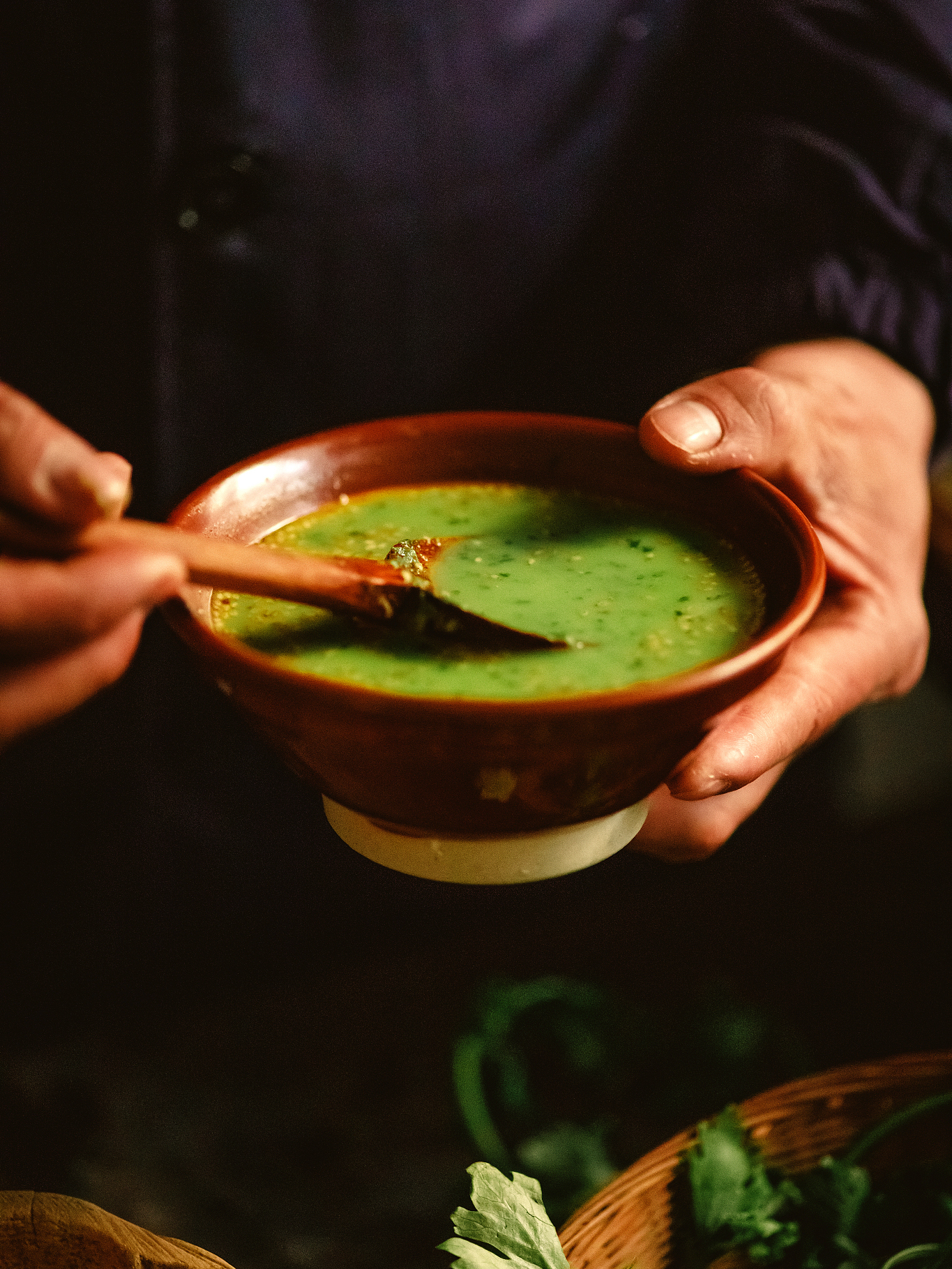
Leicha in Hunan, Jiangxi, Guangdong and other places is similar to tea porridge in Tang Dynasty
"Eating Tea Porridge"
(Tang) Chu Guangxi
The heat of the day was so hot that the birds did not fly.
Nianjun Gao Wuyin, untie the clothes in the mountains.
A few pieces of distant clouds have never covered Yanhui.
Submerged meal tea porridge, a total of my meal Fern Wei.
My hut is not far away, and the sun is returning slowly at dusk.
("Quan Tang Poetry" Volume 136)
One year, when I was wandering in Omotesando, Tokyo, Japan, I stumbled into the famous Chacha no Room. The manager of this small shop, He Tadaki, is called one of the three sages of Japanese tea by the local media. I drank a Japanese sencha called "Meteor" in his shop. Although the name is beautiful, the taste is mediocre. The overall taste of Japanese tea is weak, and the layering of aroma and sweetness is inherently deficient.
After admiring the shooting stars, it was almost noon, so I stayed in the shop to experience tea and dinner. As the saying goes, it is the bowl of tea porridge in this tea meal that left a deep impression on me. Like Japanese ochazuke, tea porridge does not see the shadow of tea leaves, but is only seasoned with rich tea soup, which has a refreshing taste and is healthy and nutritious. According to the clerk, this tea porridge is very popular among Japanese white-collar workers, and has recently become a popular fashion food.

Tang Yan Liben (Biography) "Xiao Yi Making Orchid Pavilion", the picture depicts the scene of people drinking tea in Tang Dynasty

"Xiao Yi earns Lanting" (detail)
In fact, China has had the habit of eating tea porridge since ancient times. In other words, tea porridge is also one of the many tea drinking habits in China. To talk about the story of tea porridge, we have to mention the tea poem "Eating Tea Congee" written by Chu Guangxi in the Tang Dynasty.
As usual, let’s start with the author.
Chu Guangxi, born around 706 AD, was five years younger than the poet Li Bai and twenty-seven years older than the tea sage Lu Yu. His ancestral home is Yanzhou (now Yanzhou, Shandong), and his family is in Runzhou (now Zhenjiang, Jiangsu). In the 14th year of Tang Kaiyuan (AD 726), he was a Jinshi. He served as a county lieutenant in Anyi and other places, and then resigned and went back to seclusion.
In the sixth to seventh year of Tang Tianbao (AD 747-748), he also served as Taizhu and supervisory censor. During the Anshi Rebellion, Chu Guangxi was captured by the rebels after the fall of Chang'an City, and reluctantly accepted a false post. Although he fled back to the imperial court later, he was still held accountable and demoted to Lingnan for his crimes, and finally died in the demoted office.
It is true that Chu Guangxi was not a successful politician, but he was an outstanding poet. Chu Guangxi is good at writing pastoral poems, and the patriarchal clan is naturally Tao Yuanming's poetic style. Here we might as well read a well-known poem "Fishing Bay":
Fishing in the spring of Green Bay, the deep spring is full of apricot blossoms.
The pond is clear and the water is shallow, and the lotus moves to know that the fish are scattered.
Sunset treats lover, Weizhou green Yangan.
The first two sentences describe the beautiful spring scenery of Diaoyu Bay. The first sentence points to the question, and points to the season. The two sentences and one word "random" describe the flourishing appearance of apricot blossoms, which is quite clever. Three or four sentences, write about the scenery and psychological activities seen while fishing, and the two sentences are purely written in line, with detailed objects and vivid descriptions. In the last two sentences, put aside fishing and go out of the new environment. It turns out that the poet's intention is not to catch fish, but to wait for his friends to visit. The whole poem reveals that although the poet is fishing, his attention is not only on the fish, but a kind of contented pleasure in observing the natural scenery.
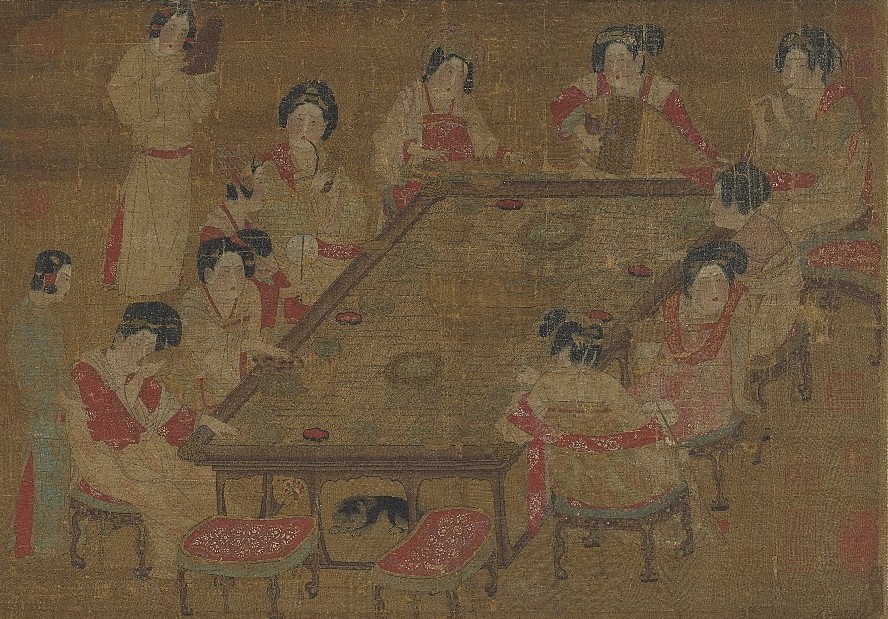
"Tangren Palace Music Picture" is in the collection of the National Palace Museum in Taipei. The whole painting depicts the scenes of women in the harem playing music and drinking tea and drinking
Perhaps because Chu Guangxi was similar to Wang Wei, who was also a famous pastoral poet, later generations would always compare the three poets Chu, Wang and Tao. It has to be said that Chu Guangxi was the literati who loved to write pastoral poems in the heyday of Tang Dynasty, and he was also the best at writing simple and unpretentious ancient style poems. Therefore, many people in later generations even feel that even Wang Wei is not as good as Chu Guangxi. For example, Shi Buhua in the Qing Dynasty said in "Xian Gong Shuo Poems": " The simplicity of Chu Guangxi's "Tian Jia" is better than that of Mojie. " Indeed, Chu Guangxi is very good at writing five-character ancient poems in the pastoral style. Including this tea poem "Eat tea and porridge", it also inherits his usual elegant style of writing.
However, in the end, Chu Guangxizhi did not become a great poet like Li Bai and Du Fu. The reason may be that the poetic style is too similar to Tao Yuanming in the Northern and Southern Dynasties. Art creation, not imitation show. Let's take tea as an example. For example, Baicha Bar originally had only a few traditional production areas such as Fuding, Jianyang, Zhenghe, and Songxi. But since white tea became popular, Yunnan, Sichuan, Guizhou and other places competed to produce white tea. For a while, there was a spectacle of white tea mountains and rivers. But imitation is imitation after all, and the "white tea" from all over the country cannot make its own characteristics, and it is still difficult to rank among the famous teas. Writing poetry and making tea are actually the same thing.
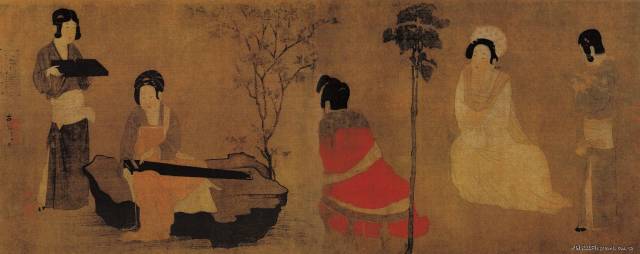
Tang Zhoufang "Tuning the Qin and Sipping Tea"
Of course, this is a harsh discussion from a literary point of view only. Chu Guangxi's "Eating Tea Porridge" takes into account both literary and tea value, and it is still a rare masterpiece of tea poetry.
After talking about the author, let's look at the topic again. In fact, tea porridge is not an invention of Tang people, but a delicacy with a long history. In Lu Yu's "The Classic of Tea", an incident related to tea porridge in the Western Jin Dynasty was recorded. It reads: "Fu Xian's "Silijiao" said, 'I heard that there was a woman from Shu in Nanshi who made tea porridge and sold it. She broke her utensils for cheap things, and then sold cakes in the market. Why is it that tea porridge is banned to trap Shu women? ?' ”
It can be seen that in the Western Jin Dynasty, there was not only the practice of tea porridge, but also hawkers selling tea porridge. So what does tea porridge look like? Let's look at poetry.
The first two sentences at the beginning are about time.
Apparently, the poem was written in the height of summer. The birds in the woods can't fly anymore, which is evident from the high temperature. In such a summer day, the poet is naturally listless. First, there is no air conditioner, and second, there is a lack of cold drinks. How could the ancients avoid the heat? The next three or four sentences are about countermeasures.
Nian, which is interpreted here as love and pity. Jun is a respectful title for friends. It turned out that Chu Guangxi went out to visit friends on such a hot day. In the heat of "birds do not fly", the poet's friend took off his "mountain clothes" recklessly, and hid in the shade of the plane tree to rest. The so-called "mountain clothes", that is, the clothes worn by hermits, the poet also took this opportunity to reveal the identity of his friends to readers. You know, the image of the elite is the most important. Not to mention the ancient officialdom, even today's workplace is the same. No matter how hot the weather is, white-collar workers in foreign companies will always have to wear suits and leather shoes. Is it hot? hot. Are you tired? tired. Can you take it off? cannot. But hermits are different. They don't care about the red tape, and they can take it off as soon as they want. They are very chic. From the word "Nianjun", it can be seen that the life attitude of this hermit makes Chu Guangxi, who has been in the officialdom, very envious.
Although he had already taken off his clothes and hid in the shade of a tree, he still felt unbearably hot. In the distant sky, there were a few white clouds floating, but they did not cover the scorching "flame light". The weather is too hot, and I can't walk, and I can't sit still. How to do it?
Drowned, that is, to retain the meaning. It was so hot that Chu Guangxi's hermit friend decided to use tea porridge as his trump card to escape the heat and reduce dryness.
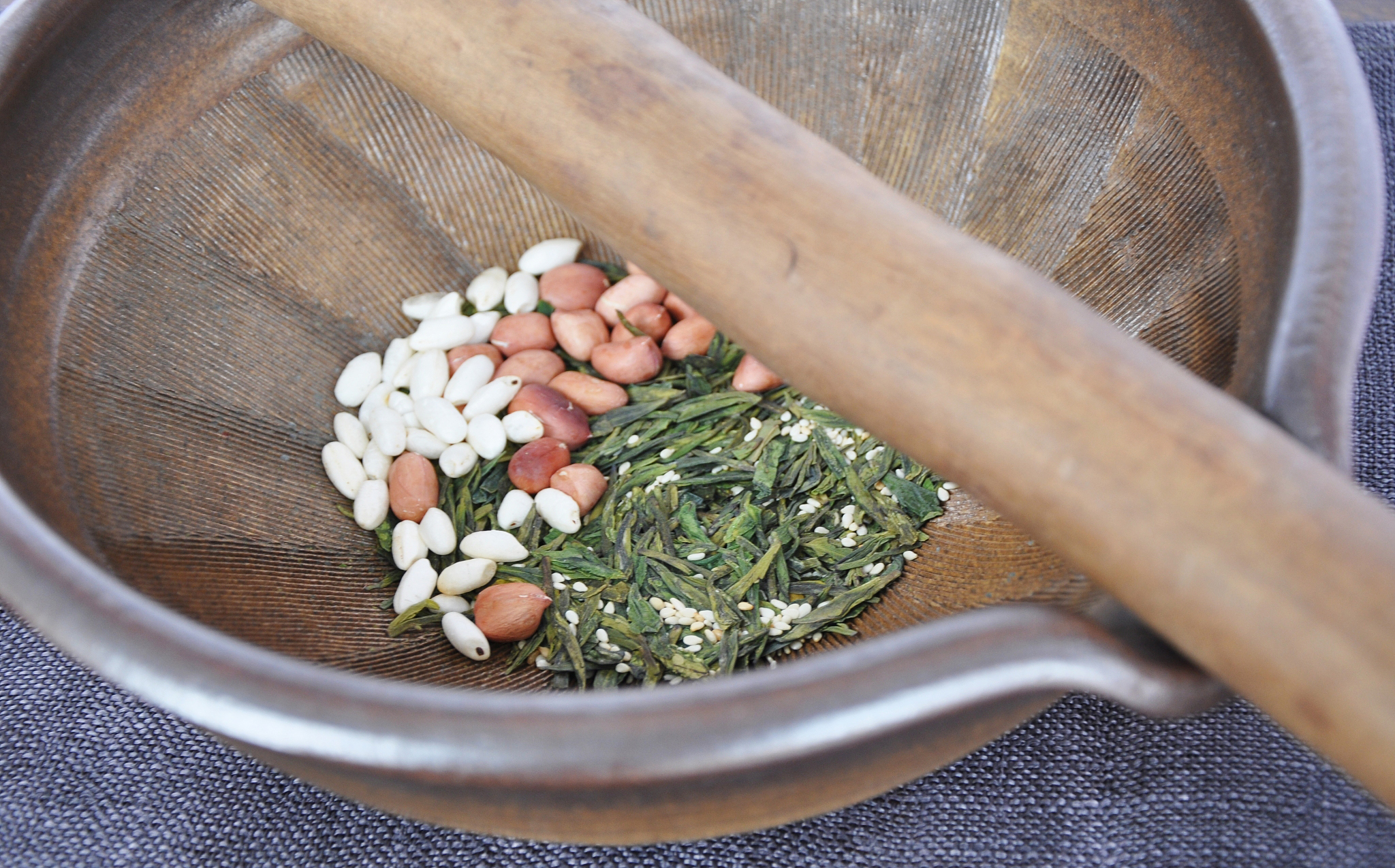
The raw materials of lei cha are slightly different from place to place
Drinking tea and porridge in summer seems to be the consensus of literati in the Tang Dynasty. For example, Wang Wei, Chu Guangxi’s good friend, said at the beginning of the tea poem "To Wu Guan":
"Chang'an's inn is as hot as boiling, and it's hard to resist the heat without a cup of tea."
Ming and tea are synonyms. Mi is boiled porridge. Therefore, the "tea porridge" in Wang Wei's works is the "tea porridge" in Chu Guangxi's poems. Eating tea porridge alone may be a bit monotonous, so it is served with some "fern weed". The so-called "fern weed" is actually wild vegetables. In the hot season, big fish and big meat are hard to swallow. Only porridge and side dishes are the most appetizing and refreshing.
The last two poems are about leisure.
A bowl of tea and porridge will clear away heat and fire, leaving a mouthful of fragrance. The poet and the hermit seem to live very close together, so they are not in a hurry to go back. When the red wheel falls to the west and the heat subsides, it will not be too late to take a leisurely walk back. The phrase "returning slowly" expresses a kind of slow life that modern people lack the most. The famous line of the Five Dynasties, "The flowers on the Moshang bloom, but you can return slowly", actually inherited the idleness of the poets in the prosperous Tang Dynasty. Such an ending is very poetic and picturesque, which arouses endless associations. In the minds of our readers, it can be a topic to form a poetic ink painting, which is subtle, meaningful and full of emotion.
Although the poem has been read, the problem has not been completely resolved. What did tea porridge in the Tang Dynasty look like? The contemporary essayist Mr. Wang Zengqi wrote in the article "Ordinary Tea Talk":
"There is tea porridge in Japan. "Hairen's Food" says that haiku people get together and the food is very simple, but 'the only one product is tea porridge, which is indispensable'. What kind of tea porridge is it? I used thick tea leaves to decoct juice and added rice To make porridge, I thought it was 'tea porridge'. For a while, I got up early every day and drank the tea porridge I invented, thinking it was delicious. "
The tea porridge described by Mr. Wang is the same as the one I drank in the tea room in Tokyo. Because tea juice is used, there is only tea fragrance but no tea leaves.
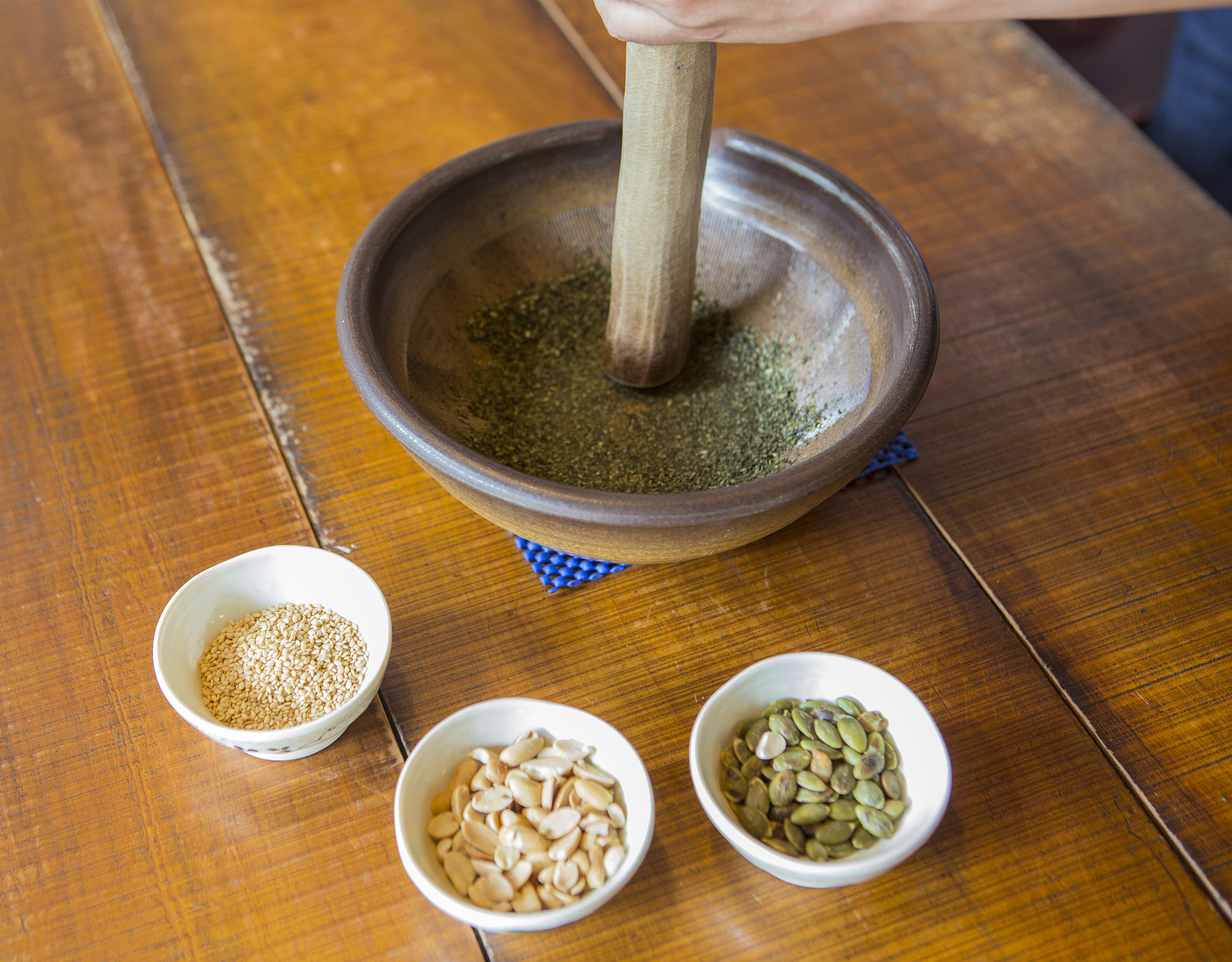
Lei Cha needs to grind the ingredients
But the tea porridge in the Tang Dynasty was not like this. The reason is very simple. Sencha method was popular at that time. Grind the steamed green tea cake and put it directly into the container for decoction. When drinking, the tea soup and tea leaves are taken together, and there is no concept of separation of tea and water. So according to my speculation, the tea porridge that Chu Guangxi drank must have tea leaves in it.
Except for the tea leaves, the content of tea porridge may still be very rich. "The Book of Tea Six Drinks" records:
"Or use onion, ginger, jujube, orange peel, dogwood, mint, etc., boil it to a hundred boils, or make it slippery, or boil it to remove the foam. The water ears are discarded in the ditches, and the custom is endless."
Obviously, Lu Yu was critical of this hodgepodge of tea drinking habits. But he himself said that at that time it was still "the custom". Chu Guangxi was nearly 30 years older than Lu Yu, so his tea drinking habit was naturally exactly the kind of "Assorted School" criticized in "The Classic of Tea". Based on this, I boldly speculate that Chu Guangxi's tea porridge for relieving summer heat contains green onions, ginger, jujubes, orange peels, dogwood, and mint.
After confirming the content of tea porridge, let's talk about the state of tea porridge.
Wang Wei is only five years older than Chu Guangxi, and he can be regarded as a contemporary poet. Wang Wei called tea porridge "Mingmi" in his poem "To Wu Guan". Mi is boiled porridge. From this clue, it can be seen that the state of this bowl of tea porridge should be boiled until it is similar to rice paste.

Leicha in Meishan has the ancient style of porridge in Tang Dynasty
Generally speaking, the tea porridge in the Tang Dynasty should be rice flour with tea and rice, as well as various spices and ingredients. There are not only the bitterness of decocted tea leaves, but also the spicy aroma of dogwood, onion and ginger, which fully stimulates the taste buds of diners. On a bitter summer day, tea porridge has naturally become a good delicacy to cool off the heat.
So can you still drink the same type of tea porridge as Chu Guangxi? It's really good. When I visited black tea in Anhua County, Hunan Province, I saw the local Meishan Leicha, which has the ancient style of Tang Dynasty porridge.
To make Meishan Leicha, the main raw materials are some fresh tea leaves, fried rice, fresh flowers and kernels, cooked peanut kernels and so on. In addition, two important tools are needed, namely the bowl and the tea stick. The so-called Leibo is a kind of rough pottery made locally. The size is like a steamer, but it is inverted conical, and there are rows of dark teeth inside to speed up the grinding. As for Lei Cha sticks, they are wooden sticks half a meter long. It is mostly made of camellia wood that has borne camellia fruit, which is durable and fragrant.

Tea Man Lei Cha, Anhua County Radio and Television Station/Photographed by Wang Ting
When playing Lei Cha, the locals sit down, fix the bowl with their legs, hold the stick tightly with their right hand, stabilize the edge of the bowl with their left hand, and poke it down. Make rhythmic noises. Generally, when making Lei Cha, rice, raw peanut kernels and raw sesame are firstly boiled, then freshly picked tea leaves are added, and roasted peanut kernels are added last. These ingredients are not simply brewed, but boiled on fire, and the final state is not a clear soup with little water, but a mushy and sticky soup.
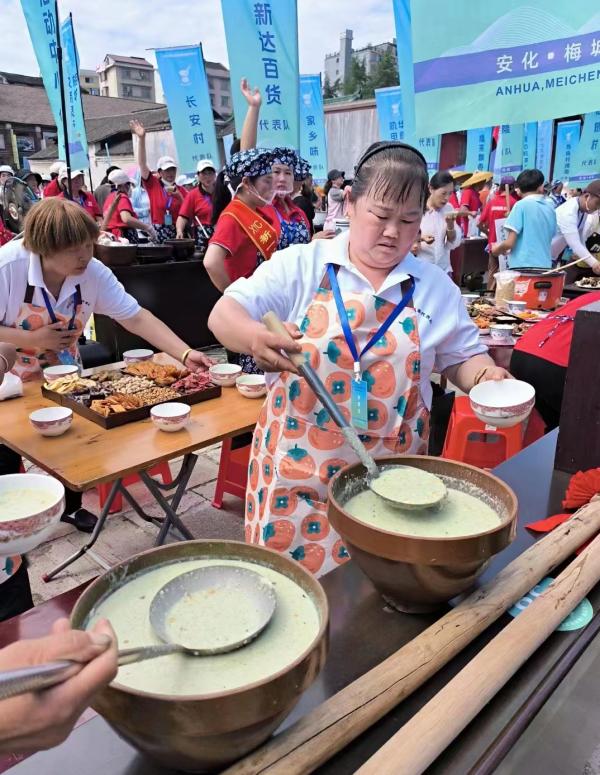
The Leicha Contest held in Anhua County, Anhua County Radio and Television Station/Photographed by Wang Ting
The fragrant fried rice with nuts, together with the blending of tea juice, creates a unique flavor of Meishan Leicha with moderate sweetness and saltiness, thick and soft taste. The local people still keep the living habit of three meals and two teas. Relieve the heat in summer, drive away the cold in winter, delicious and healthy. What's more interesting is that the local people are used to say "eat Lei Cha" instead of "drink Lei Cha". Doesn't this coincide with what Chu Guangxi said in "Eating Tea Congee"?
If you have the opportunity to go to Anhua, besides drinking a cup of black tea, don’t forget to eat a bowl of Lei Cha.
The custom of drinking tea like a living fossil is the legacy of the Tang Dynasty.
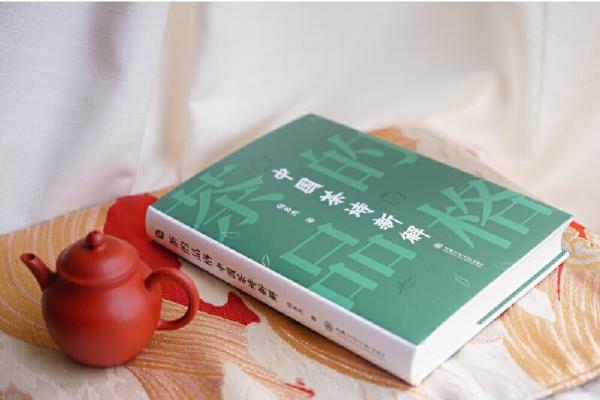
Yang Duojie's "The Character of Tea - A New Interpretation of Chinese Tea Poetry"
(This article is excerpted from "The Character of Tea - A New Interpretation of Chinese Tea Poetry", published by The Paper with authorization)